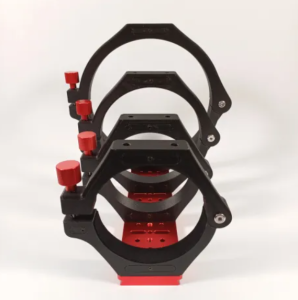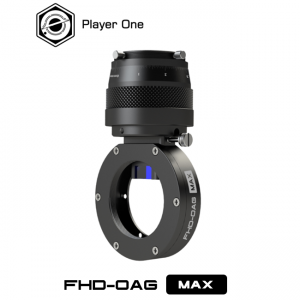Rouz Astro Tube Rings are now offered in an updated design to be even more lightweight and stronger than before. These telescope mounting rings are CAD designed and FDM printed for a combination of exceptional strength and low weight thanks to the tough carbon fiber composite material that offers excellent mechanical properties.
 Unlike traditional metal rings that can be add significant weight to a set-up, these light-weight rings can significantly increase mount performance and image quality. When paired with Rouz Astro’s lightweight bottom and top dovetails, users can save several pounds of weight, at times more than the OTA itself.
Unlike traditional metal rings that can be add significant weight to a set-up, these light-weight rings can significantly increase mount performance and image quality. When paired with Rouz Astro’s lightweight bottom and top dovetails, users can save several pounds of weight, at times more than the OTA itself.
The Rouz Astro Tube Rings offer engineering grade material which includes a composite of polymers and carbon fiber which are fused at high temperatures of over 500 deg F (no glue or epoxy is used). All bolts are threaded into oversized implanted CNC stainless steel receptors and the oversized hinges also use stainless steel hardware.
The Rouz Astro Tube Rings specifications include:
– Felt lined
– Hinged design
– Implanted stainless steel threads
– Bolt spacing: 2.0 inches – 50.8mm – M6
– Weight per ring: 200 to 500 grams per ring (depending on size)
– Material: Carbon Fiber composite – FDM Print
– CNC aluminum knobs (red)
– High UV, water and temperature resistance up to 60 deg C (140F)
You can learn more about the Rouz Astro Tube Rings here.
And to make it easier for you to get the most extensive news, articles and reviews that are only available in the magazine pages of Astronomy Technology Today, we are offering a 1-year magazine subscription for only $6! Or, for an even better deal, we are offering 2 years for only $9. Click here to get these deals which only will be available for a very limited time. You can also check out a free sample issue here.
The Sun is more active than it’s been in years and if that’s not enough, we have the upcoming Total Solar Eclipse on April 8, 2024! If you’d like to learn more about the technology behind solar observing, solar imaging and more, you can check out our new monthly magazine – Solar Astronomy Today. It’s free to read, no subscription needed and available here. And if you are preparing for the upcoming eclipses and want to know your equipment options from solar glasses to the most out of this world solar viewing and imaging options, check out our free publication – The Definitive Guide to Viewing and Imaging the Sun – simply click here and enjoy reading!



